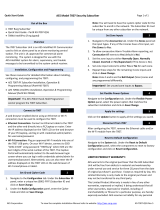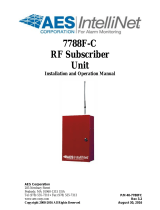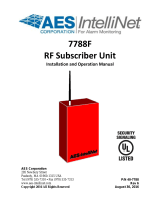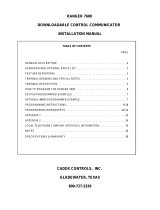Page is loading ...

Out of the Box
1. IntelliPro Module (1) AES Part# 72-7094A
2. RJ11 Cable (1) AES Part# 13-0395
3. Kepnuts (4) AES Part# 09-1006
4. Insulating washer (2) AES Part# 09-7X94
Overview
The 7094A full data module is an alarm reporting interface for the AES
Model 7007 Security Subscriber Unit. The 7094A is UL listed for use in
Commercial Security Installations with or without a phone line. This
document describes installation of AES Model 7007 subscriber with the
interface to an Alarm Panel (AP) via the AP dialer interface. The 7094A
decodes a CID, PULSE, Modem II, or a Modem III message received on its
AP phone interface and sends the message via the AES subscriber radio.
The 7094A also provides a full replacement to a POTS line as well as POTS
monitoring when POTS is present.
User Interface
A web browser and network connection to the Model 7007 subscriber is
required to program the 7094A. The 7094A has one STATUS LED to
indicate operation and heartbeat.
Installation
1. Be sure primary and battery backup power to the subscriber are
disconnected.
2. Remove the four (4) lower hex nuts holding the main board inside
the 7007 enclosure. Save the nuts.
3. Mount the 7094A board on standoffs, and secure with 4 kepnuts
(provided with 7094A).
4. Install insulating washer (provided with 7094A) over H1 (upper left
corner) H3 (lower left corner).
5. Secure the 7094A with the 4 nuts removed in Step 1 above.
6. Install the 6 wire modular cord (provided) between 7094A J1 and
7007 subscriber connector J7 ARM. Power up the subscriber.
LIMITED PRODUCT WARRANTY: AES warrants to the original purchaser
that the AES Subscriber Unit will be free from defects in material and workmanship
under normal use and service for three (3) years from the date of original
purchaser’s purchase. Except as required by law, this Limited Warranty is only
made to the original purchaser and may not be transferred to any third party. This
Limited Product Warranty is made in lieu of any other warranties, expressed or
implied, it being understood that all other warranties, expressed or implied,
including of merchantability or fitness for a particular purpose, are hereby
expressly excluded. AES assumes no liability for any personal injury, property
damage, consequential damages, or any other loss or damage due, among other
things, to this product’s failure to operate or provide adequate warning. AES’s sole
responsibility is to repair or replace, at AES’s sole option, the AES product that is
judged defected by AES during the limited warranty period under the terms of its
Limited Warranty.
Firmware Version
The firmware version is displayed in the web browser Status page
under the Hardware–Panel Interface.
7094A Configuration
Select the Accessories page. Use controls in the IntelliPro panel to
set parameters.
Item
Parameter
Default value
1
Phone line
No
2
Intercept Number
555
3
AP Report Format
CID
4
AP input gain
20
5
Intercept on blind dial
No
6
Line Cut Report
Yes
7
POTS Cut Report Delay
45 sec
8
POTS Restoral Delay
60 sec
9
AP ACCT Override
No
10
POTS Input Gain
20
11
Advanced Options Display
No
12
AP Output gain
3
13
Reset to defaults
-
14
Line-cut sensing Enabled
Yes
15
CID 4xx Letter
U
16
M3 EC TEXT to CID
Yes
17
Voltage Pump Enabled
Yes
18
Clock Freq. Shift Enabled
No
CONFIGURATION SETTINGS
Phone line: YES or NO for POTS line presence.
Intercept Number: Enter a phone number such as 555.
AP report format: CID, MODEM and PULSE depending on Alarm
Panel.
FOR MODEM SELECTION
AP MODEM format: Set to MODEM2 or MODEM3. If you select
MODEM3 format, set Advanced Options to YES to set M3 Text to CID.
This table shows panel models tested and the MODEM format supported.
Panel Model
Revision Number
Format Tested
D7412GV2
7.08
Modem III
D7412GV3
8.03
Modem III
D8112E1/G1
22
Pulse Only
D8112G2
31.31
Modem II
D6112
4.0
Modem II
D2212B
3.03 (IIe = III)
Modem III
D4412
1.12
Modem III
D9412G
6.6
Modem III
FOR PULSE SELECTION
Parameter
Default value
Available values
Handshake Duration (HSD)
0.8 sec
0.8, 0.4
Handshake Frequency (HSF)
1.4 KHz
1.4, 2.3
Center Frequency (CF)
1.8 KHz
1.8, 1.9
Inter-Digit Time (IDT)
0.7 sec
0.7, 0.9, 1.7
Inter-Round Time (IRT)
3.0 sec
3.0, 5.0
Quick Start Guide
AES Model 7094A IntelliPro
Page 1 of 2
AES Corporation
To view the complete Installation Manual, refer to website: http://aes-corp.com
40-7094A-QSG Rev. 4 4/15/2019

The following table shows common PULSE formats used by alarm panels
and the values of parameters for each pulse format.
HSD
HSF
CF
IDT
IRT
Pulse Format
sec
kHz
KHz
sec
sec
Ademco LS (10 pps) (4+2)
0.8
1.4
1.9
0.9
3
Ademco LS (10 pps) (3+1)
0.8
1.4
1.9
0.9
5
Ademco LS (10 pps) (4+1)
0.8
1.4
1.9
0.9
5
Ademco LS Double Round (3+1
Expanded)
0.8
2.3
1.9
1.7
5
Ademco HS Double Round (3+1
Expanded)
0.8
2.3
1.9
0.9
5
Ademco Slow Silent Knight
Slow, HS 1400 Hz
0.8
1.4
1.8
1.7
5
Ademco Slow Silent Knight
Slow, HS 2300 Hz
0.8
2.3
1.8
1.7
5
Radionics Fast (20pps) (4+2)
0.4
2.3
1.8
0.7
3
Radionics Fast (20pps) (4+1)
0.8
2.3
1.8
0.7
3
Radionics Fast (20pps) (3+1)
0.8
2.3
1.8
0.7
3
Radionics (20pps) (4+2)
0.8
2.3
1.9
0.7
3
Silent Knight LS Double Round
(3+1 Expanded)
0.8
2.3
1.9
1.7
5
Silent Knight HS Double Round
(3+1 Expanded)
0.8
2.3
1.9
0.9
5
Silent Knight Fast
0.8
2.3
1.9
0.9
5
Silent Knight (4 + 2)
0.8
1.4
1.9
1.7
5
Universal High Speed, hand
shake 1400Hz
0.8
1.4
1.8
0.7
5
Universal High Speed, hand
shake 2300Hz
0.8
2.3
1.8
0.7
5
NOTE: Only applicable settings show on the web GUI while configuring the settings
below
AP input gain: Options are either 10 or 20 to set input gain.
Intercept on Blind dial: Options are either YES or NO to enable or disable intercept
on blind dial.
Line cut Report: Options are either YES or NO to enable or disable line cut report.
NOTE: This setting is only effective when POTS=YES.
POTS cut report delay: The default value is 45 sec and the maximum is 9999.
POTS restoral delay: The default value is 60 sec and the maximum is 9999.
AP ACCT Override: Options are either YES or NO to enable or disable AP ACCT
override.
POTS Input gain: Option to set POTS Input gain are 0, 10 or 20.
Advanced Options Display: Options are either YES or NO to enable or disable the
advanced options display respectively.
AP Output gain: Options to set AP Output gain are 0, 3 or 6.
Reset to defaults: Select the Systems page tab. Under the Reset to Default
Configuration panel, set the IntelliPro Config to Yes and click on Reset
Configuration.
Line-cut sensing Enabled: Options are either YES or NO to enable or disable line
cut sensing.
CID 4xx Letter: Options are either U or C for reporting open and close reports with
“U” or “C”
M3 EC TEXT to CID Enabled: Options are either YES or NO to enable or disable.
Voltage Pump Enabled: : Options are either YES or NO to enable or disable the
voltage pump.
Clock FShift Enabled: Options are either YES or NO to enable or disable the
control.
Interpreting the LED Blinking Patterns
The 7094A has one single RED LED that has a slow blinking pattern (1 pulse per
second) when all is working properly. If it becomes SOLID, it is a malfunction and
the board has to be sent for maintenance. If it blinks at a faster rate (2 pulses per
second) it indicates that the 7094A cannot communicate with the subscriber.
Usage of 7094A without a Phone Line
Program Phone Line = NO. The 7094A will generate all the voltages to emulate an
actual phone line. Emulation is 100% compatible, issuing the wet voltage, dial-
tone, ring back, and full DTMF digits decoding. Figure shows the typical wiring
diagram without a phone line. Connect the Tip and Ring of the AP to the terminal
block labeled: AP TIP RING on the 7094A.
Usage of 7094A with a Dedicated Phone Line
The 7094A is capable of decoding all the DTMF digits present on a typical PSTN
phone connection. Connect the Tip and Ring of the AP to the terminal block
labeled: AP TIP RING. Connect the Tip and Ring of the POTS to the terminal block
labeled: RJ31TELCO TIP RING. Figure shows the typical wiring diagram with a
phone line:
Intercept on specific dial sequence
Set to Phone Line = YES, and enter the phone number that the AP dials. This can
be the single phone number or you can have dual numbers programmed on the
AP, so one of the numbers will engage the 7094A. The default intercept number on
7094A is 555. With default intercept number on 7094A, you can program the AP
with 5555(4 digits) if you want 7094A to intercept.
NOTE: When a phone line is present, and it is removed (line cut), the 7094A
engages the phone line simulation immediately, so the panel does not notice that
there is no phone line, and in this case, 7094A will act on any number dialed.
Intercept on any dial sequence
Set to Phone Line = YES, and enter the phone number as *** (3 asterisks). This will
cause the 7094A to engage on any number dialed, with 3 or more.
Using 7094A with a Shared Line
1. Connect the Tip and Ring of the AP to the terminal block labeled: AP TIP
RING. Connect the Tip and Ring of the POTS to terminal block labeled:
RJ31 TELCO TIP RING
2. Connect the Tip1 and Ring1 of the AP to terminal block: AP TIP1 RING1
3. Connect the Tip and Ring of the RJ31CPE to term. Block: RJ31CPE TIP RING.
Figure below shows the typical wiring diagram with a phone line along with
CPE (Customer Premises Equipment).
POTS Line Monitoring and Reporting
When Phone Line = YES, the 7094A also monitors the presence of the phone line.
In case the line is cut, the 7094A immediately engages the phone line emulation. If
Line Cut Reporting is enabled the programmable timer (default is 45 seconds,
programmable) starts counting. If the line is restored before the timer expires, no
alarm is sent. However, if the timer expires, a line cut alarm is sent (E351 C905).
Reducing Receiver Noise on 419.5375 MHz & 451.5875 MHz
Setting Clock Freq Shift=YES under Advanced Options will reduce receiver noise on
these two frequencies. No other IntelliPro options are changed when changing this
option. The 7094A will save the new configuration and exit the menu immediately.
NOTE: This option must not be used on other radio frequencies.
Quick Start Guide
AES Model 7094A IntelliPro
Page 2 of 2
AES Corporation
To view the complete Installation Manual, refer to website: http://aes-corp.com
40-7094A-QSG Rev. 4 4/15/2019
/









